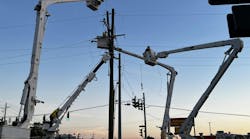As stated in OSHA 1910.269(a)(2)(i)(B): Each employee shall also be trained in and familiar with any other safety practices, including applicable emergency procedures (such as pole-top and manhole rescue), that are not specifically addressed by this section but that are related to his or her work and are necessary for his or her safety.
As a lineman, I was required to participate in Annual Refresher Training for Hurtman Rescue. I had been doing the same type of rescue since 1986 without any significant changes to the method. The rescue was based on the same methods employed at the Lineman’s Rodeos. My teams won twice at the International Lineman’s Rodeos and practiced hundreds of times to decrease our times and run perfect for the competition. We could successfully run our times in 1:00 - 1:05 minutes with our tools laid out and the ability to free-climb 45-ft poles with no obstructions.
As any lineworker knows, however, that is not often the case in the real world. Oftentimes, you can face many unforeseen challenges when rescuing an injured worker from a pole. For that reason, I believe our industry must “course correct” and change the way the training is provided at each organization.
Reviewing Traditional Training Methods
In 2021, I was contracted by several utilities to evaluate hurtman rescue training of the utility’s lineworkers (pole top and bucket) and substation workers (bucket rescue only). I was asked to provide evaluations, a written report and feedback about improvements in methods along with general and specific items that need to be addressed for this type of training.
The workers performed the pole top rescue by ascending to the top of a wood pole where the mannequin was secured between 35 ft to 40 ft above the ground. These methods were used:
- Crossarm method. Split the handline, place the fall line over the crossarm with one-and-a-half wraps and wrap the line around the mannequin and secure it with three half-hitches. Then drop the handline sheave to the ground, cut the strap and lower the mannequin down under control.
- Screwdriver method. Drive the screwdriver in above the mannequin, split the handline and using the fall line, take a wrap around the pole above the screwdriver (ensuring that the load line is under and not over the fall line). Then wrap around the mannequin and secure with three half-hitches, cut the strap and lower the mannequin down under control.
- OX Blok. The OX Blok eliminates the need for using the crossarm or the pole as a friction/braking method of lowering the mannequin under control. The worker will leave the Blok/sheave on the pole or crossarm, split the handline and wrap the mannequin. Using the fall line, he or she will take two wraps around the friction bar of the Blok, cut the strap and lower the mannequin.
- Bucket Rescue Method. For the bucket rescue method, the bucket is elevated about 30 ft and rotated 90 deg to the side of the vehicle. The mannequin is placed at the bottom of the bucket. The rescuer activates the lower controls, rotates the bucket to the back of the truck and lowers the bucket.
- Rescue Blocks. A pre-packed bag with a set of four rescue blocks in the bag is attached about 7 ft up on the upper boom above the bucket. The rescuer will open the bag and attach the blocks to an anchor point on the boom (typically a strap with a D ring). Pulling the blocks free, they will attach the blocks to the mannequin’s D-ring on the harness and pull the blocks lifting the mannequin out of the bucket and lowering them to the ground. The same method can be used if there is a material handling jib on the bucket. In this case the rescuer will use the winch line on the jib to lift the mannequin.
- Dump Method. For the dump method, the rescuer will lower the bucket to the ground, pull the pin on bucket and swivel the bucket to be able to dump the bucket and pull the mannequin out of the bucket.
For the procedures that are used, the rescuer will tell the other workers to call 911 and then proceed to perform the rescue or shout out some other commands per the company’s policies prior to performing the rescue.
Making Modifications
The problems with these training scenarios are they lack real-life conditions that are found in the field. For traditional pole top rescue training scenarios, the rescuers’ tools are placed at the butt of the pole in such manner to facilitate a speedy tool up. It’s with a reasonable degree of certainty that this is never the case in the real world.
When providing hurtman rescue training, utilities must ask themselves why they are practicing it. The usual response is an electrical contact causing the worker to become injured and unable to respond. However, the industry standard for working primary distribution energized lines is to have two qualified electrical workers working together on the same pole. Does that mean we can eliminate the tooling up process for the rescue since the rescuer would already be on the pole?
If a worker is injured on the pole and the rescuer must ascend, is it possible that the injured worker may still be in contact with the energized conductor? If so, what will the rescuer have to do to make the conditions safe for the rescue?
What about the four-minute rule? Brain cells will die in about four to six minutes without circulating blood carrying oxygen to it. You only have four minutes to perform the rescue and begin CPR. That is a very tight time frame if it takes the worker several minutes to get their tools off the truck, tool up, ascend the pole, rig the injured worker and get him or her down to perform CPR.
Challenges with Current Methods
Utilities also need to ask themselves about the condition of the poles. Distribution poles are not like Lineman’s Rodeo competition poles. They typically have multiple runs of telecommunications, fiber, risers, secondary supply, services and multiple distribution circuits. Ascending to perform the rescue will require the rescuer to be able to maneuver around and over these obstacles, which used to be challenging when we are able to free climb. In. my view, trying to do this while using all the wood pole fall restriction devices is even more difficult and time consuming.
Is it reasonable to expect that a rescuer can perform a pole top rescue under four minutes if their tools aren’t already laid out, there are multiple obstructions on the pole and they having to use fall protection devices?
Another thing to keep in mind is the physical condition of the rescuer. Let’s say you have a foreman who doesn’t climb on a regular basis, and the only time they climb is to do their annual refresher training. Will they be able to perform up to the standard? If there are obstacles in the way, how can you effectively “tag out” the injured worker around those obstacles if you drop the other end of the handline?
The bucket truck rescue is different since there is no tooling up required, but it still has challenges. What if the truck is energized and the system protection doesn’t activate? How many companies don’t ground their trucks when working in proximity to energized lines? What if the system you’re working on doesn’t have a system neutral and you’re relying on the earth as your ground? Does the groundman know how to operate the controls to lower an injured worker? Does your company barricade the truck and provide an EPZ mat when getting on and off and set aside a transition area from the ground to the EPZ mat?
Doing the same thing every year just to say you're in compliance with OSHA doesn’t mean your organization is close to creating and ensuring a safe working environment. Annual recertification training is not enough to adequately address catastrophic events in the field. Your workers should be discussing emergency rescue operations every day prior to the start of work during the tailboards.
Performance evaluations should reflect the ability of the individual to perform physically demanding work daily. Policies and procedures should be reviewed periodically by a committee of subject matter experts including the safety department, lineworkers, substation electrical workers, engineers and other critical workers in the organization to ensure that they are applicable and up to date with current industry standards as they relate to safety.
Editor’s Note: To learn more about how to improve your hurtman rescue training program, listen to the May 2022 Line Life podcast featuring an interview with Field Editor Amy Fischbach and Maximo Fuentes. Visit https://anchor.fm/line-life-podcast to play the episode.
Maximo Fuentes ([email protected]) retired as the Grid Assets T&D Line Supervisor-Business Operations for the Sacramento Municipal Utility District in Sacramento, California. He now owns a consulting business, Fuentes Consulting LLC, a company that provides technical consulting, leadership development and expert witness services to the transmission and distribution utility industry.


